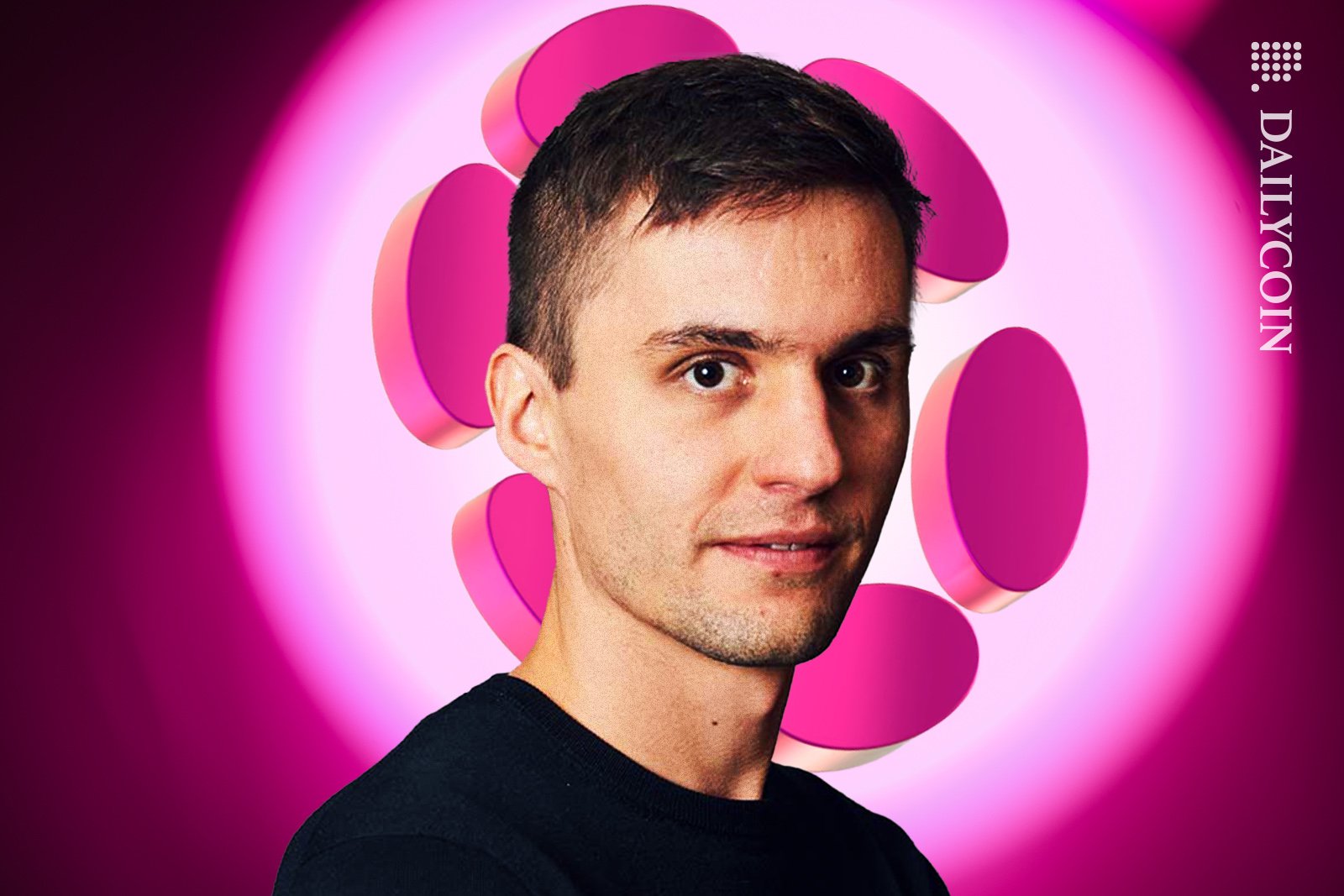Peter Czaban is much more than just the “Web3 Foundation guy.” In truth, he’s been involved in numerous ambitious projects over his career and played an integral role in launching the multi-chain network now known as Polkadot (DOT).
Unfortunately, Peter’s contribution to Polkadot, and even Ethereum, often goes ignored by the crypto media due to him only really gaining popularity with the establishment of the Web3 Foundation.
Today, we’ll be digging deeper into Peter Czaban’s life to understand how he started out in the crypto world and what led him to become a co-developer of a juggernaut like the Polkadot network.
Who Is Peter Czaban?
Peter Czaban is currently the technology director of the Web3 Foundation and one of three co-founders of Polkadot. As the name implies, the Web3 Foundation provides resources and grants to next-generation projects contributing to a fully decentralized World Wide Web, also commonly known as Web3.
Polkadot is a multi-chain network that allows individual blockchains to communicate with one another. This is achieved through the use of small custom-made blockchains known as parachains, which essentially act as bridges.
Peter Czaban has become somewhat of a household name in crypto and Web3 circles, but before we get there, let’s take it back to where it all began for him.
Early Life
It was clear early on in his high school career that Peter was a smart student with a bright future ahead of him. Initially, he was fascinated by physics, and his personal school projects would eventually catch the attention of Krajowy Fundusz na rzecz Dzieci; a Polish non-government organization that supports the education of highly gifted children.
Years later, he attended the prestigious University of Oxford to study machine learning. It’s here that he became familiar with probabilistic programming, a complex form of code that has become integral to several crypto protocols, including Bitcoin.
As a result, his interest in machine learning inevitably led Peter to Bitcoin, where he would start off doing some simple algorithm trading. After he discovered that there were other types of coins out there, such as peer coins and prime coins, Peter’s crypto interest had peaked, and before he knew it, he was regularly attending Ethereum meetings and conferences in London to learn more.
Parity and Peter
Peter graduated from university in 2016 with a Masters Engineering degree, and after feeling that he could apply his skills to the ever-growing crypto space, he decided to contact Parity Technologies upon finishing his education.
Parity is designed to support the Ethereum client, so since Peter already had a solid understanding of Ethereum, and was adept in cryptography thanks to his machine learning days, he was given the chance to work on consensus algorithms. These lie at the heart of a blockchain and allow transactions to be verified by maintaining order on the system.
It didn’t take long before he was also helping to build decentralized applications along with the rest of the team, such as Whisper, which allows users to hide the contents of their messages and their identity from any external observers.
He may not have been one of the biggest names at Parity Technologies, but Peter’s skills were more than enough to catch the attention of Ethereum’s founder, Gavin Wood, who invited him to start working on a brand new project.
The Emergence of Polkadot
In 2016, it had become obvious to Gavin Wood and other members of the team that Ethereum wasn’t going to be leading the charge for establishing a Web3 internet. According to Peter, he felt personally that, although blockchains were initially designed to connect people together, the lack of trustless bridges presented an obstacle that crypto developers would need to face head-on sooner rather than later to make this a reality.
He also believed that Ethereum’s security model, which forced users to find their own miners for a blockchain, was too cumbersome and involved too much effort, especially by modern-day standards.
As a result, Polkadot, a multi-chain project that could allow blockchains to interact as part of one collective framework, started to seem like a necessity for the crypto world.
The Move to Web3
By 2017, the Polkadot network began taking shape, but it became clear pretty quickly that if Gavin and the team wanted such an ambitious project to flourish, they needed external support. As a result, Peter, along with Gavin and Ashley Tyson, founded the Web3 Foundation that same year, with Peter being made the technology director.
Though Polkadot was the foundation’s flagship project, it also supported anyone making big strides toward establishing a fully decentralized Web3 future.
What’s important to note here is that the group doesn’t actually do any development themselves but instead provides three things to assist other groups with their projects: research, resources, and grants.
Peter was the spokesperson for Web3, and throughout 2017 and 2018, he held numerous live conferences to discuss the core concepts of both the foundation and Polkadot.
Substrate, which is the toolbox that allows developers to create a custom blockchain, was a particular topic of focus since it was an easy gateway to invite developers into the project, without overwhelming them with information.
Polkadot’s Watchful Eye
Though Peter’s time was spent as a director at the Web3 Foundation, he wasn’t completely hands-off about Polkadot as a whole.
When it was time to start testing the real thing in late 2019, the Web3 Foundation led the charge. Peter and his team began by launching Kusama, a canary network that was used as a testing ground before the official network went live.
Kusama was a success, and on May 26th, 2020, the Web3 Foundation took the bold step of launching the initial version of Polkadot. During this period, staking options and governance protocols hadn’t yet been fully established, so the network was governed by the Web3 Foundation, which retained control over it.
It was only a month later, when enough validators joined the network to maintain it, that Peter and the rest of Web3 handed over the reins to DOT holders, effectively birthing the modern Polkadot as we know it today.
A New Planting Space
Today, Peter is the chief technology officer at the Web3 Foundation, where he continues to support Polkadot and like-minded projects in achieving their decentralized ambitions. As if this wasn’t already enough work, he also established a brand new organization in June 2019, Planting Space.
Planting Space collects data analytics and information from across the internet for people to use quickly and effectively. For example, while it would usually take a research assistant or scientist hours to flick through digital booklets and documents, Planting Space can help them find what they need in a fraction of the time.
Peter’s machine-learning experience again came into play here. During his time at Ethereum, he realized that these learning methods can be inaccurate and intransparent, which inspired Planting Space.
Though this organization has less to do with crypto, Peter still advocates for Web3 and blockchain expansion in conferences, podcasts, and interviews, and it doesn’t seem as though his passion is going to die down any time soon.
How Important Was Peter to Polkadot’s Development?
Try and picture how messy and chaotic the first initial stages of Polkadot’s launch must have been. With a lack of governance and no DOT tokens to speak of, it was pretty much a wild wasteland, but the Web3 Foundation, and by extension Peter himself, held this together long enough for the network to become fully reliable.
As the leader of the platform’s biggest daughter company (Web3 Foundation), he provided much-needed support not just in terms of governance but also in terms of promoting Polkadot through lectures, talks, and podcasts.
There’s a chance Polkadot may have still existed without Peter, but it certainly would have taken much longer to establish.
On the Flipside
- Peter’s contribution to Polkadot cannot be understated, but the platform could never have taken flight without other talented members of the Polkadot team also doing their part, especially Robert Habermeier, who played a huge role in developing the network itself.
Why This Matters
Peter Czaban is a prime example of someone who invested all their efforts into crazy and ambitious ideas, yet managed to make them work thanks to his hard work and dedication to the wider vision.
Both Polkadot and the Web3 Foundation were risky ventures that weren’t guaranteed to succeed, but rather than playing it safe and taking his talents elsewhere, Peter believed wholeheartedly in the projects he worked on and in the colleagues he worked alongside to make these ideas a reality.
FAQs
Polkadot does not natively support the execution of smart contracts, but users can find specific parachains that are designed to do so.
The current market cap for the Polkadot network is over 10 billion dollars.
Peter studies physics, mathematics, and computer science while attending the August Witkowski 5th High School.
Sourced from dailycoin.com.
Written by on 2024-06-30 12:00:00.








